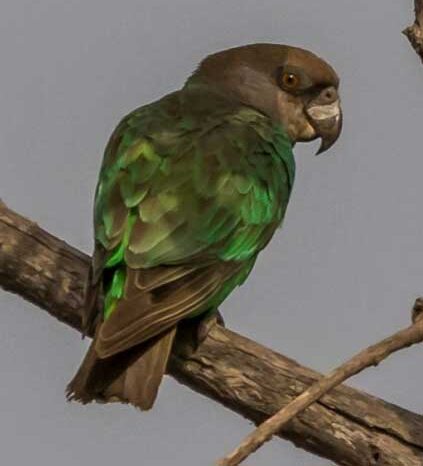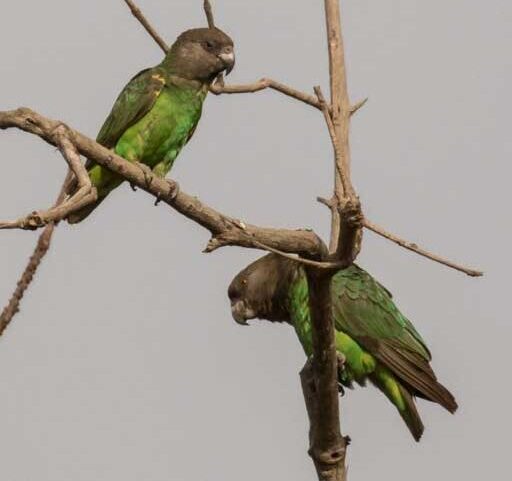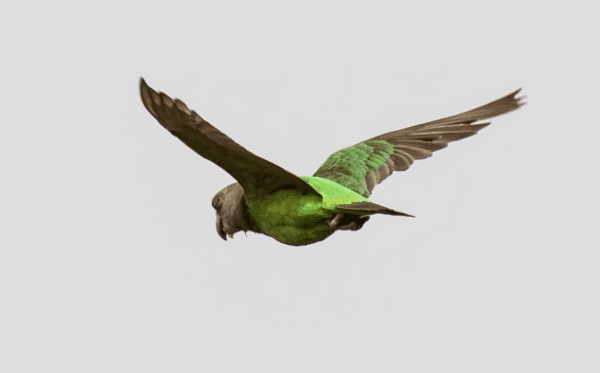DID YOU KNOW?
In the field, a good way to identify Poicephalus species is to observe its flight – the wingbeats meet underneath the body, unlike other parrots.

Poicephalus

crassus
Size:
25 cm (9.75 in)
Weight:
—
Subspecies including nominate:
one
Colour Adult:
Both adults brown head and neck tinged with olive/yellow; olive/brown throat and breast; silver/grey ear coverts; green underwing coverts; olive/brown tail tipped with dull green. Grey/brown upper mandible tipped with black, yellow lower. Cere and eye ring bare and dark brown/grey. Eye yellow.
Colour Juvenile:
Grey/brown crown and nape strongly marked with olive/yellow; yellow edging on inner secondary feathers. Yellow upper mandible tipped with dark grey, yellow lower.
Call:
Calls made in flight or when perched are very sharp, which can be heard at some distance. Becomes more high-pitched with alarm.
Content Sources:
CITES
BirdLife International
Cornell of Lab of Ornithology/Birds of the World
Parrots: A Guide to Parrots of the World, Juniper and Parr, 1998
Parrots of the World, Forshaw, 2006. 2010 edition
Parrots in Aviculture, Low, 1992.
Lexicon of Parrots, Thomas Arndt.
Captive Status:
Rare
Longevity:
—
Housing:
Flight 2 x 1 x 2 m (6.5 x 3.3 x 6.5 ft); minimum temperature during acclimatisation 20 C (68 F), afterward not less than 10 C (50 F).
Diet:
Seed mix such as: safflower, paddy rice, wheat, oats, canary, buckwheat, Pinus seed, millet; millet spray, dry or sprouted; limited sprouted sunflower seed; fruits such as: apple, pear, orange, banana, cactus fruits, pomegranate, papaya; vegetables such as: carrot, celery, green beans and peas in the pod; berries such as: rosehips, rowanberries or elderberries; green leaves such as: Swiss chard, lettuce, kale, sowthistle, dandelion, chickweed; complete pellet.
Enrichment:
Are vigorous chewers so provide plenty of bird-safe, unsprayed woods such as: pine, fir, elder, willow or saskatoon bush. Also provide wooden block and vegetable tanned leather toys and heat sterilized pine cones.
Nest Box Size:
—
Clutch Size:
Not recorded.
Fledging Age:
—
Hatch Weight:
—
Peak Weight:
—
Weaning Weight:
—
World Population:
Unknown but presumed to be common, decreasing.
IUCN Red List Status:
Least Concern
CITES Listing:
Appendix II
Threat Summary:
Not globally threatened. Largely unknown African parrot; needs more study to confirm abundance. Occurs uncommonly in Manovo-Gounda-St. Floris National Park, Central African Republic and is rare in Sudan. Is considered to have a medium dependency on forest habitat, and tree cover is estimated to have declined by 2.1% within its range over the past three generations. Therefore it is tentatively suspected that this may have led to a 1-19% decline in the species’ population over the same period.
Range:
WC Africa from S Chad and possibly E Cameroon, east to N Democratic Republic of Congo and SW Sudan.
Habitat:
Found up to 1000 m (3280 ft) in wooded savanna country, forest savanna mosaic, moist savannas and Syzygium-Adina riparian woodland in savanna.
Wild Diet:
Probably includes a variety of seeds; also millet and grain.
Ecology and Behaviour:
Resident with local movements to and from feeding areas. Seen in pairs or small groups. Wary and difficult to approach.
Clutch and Egg Size:
Not recorded.
Breeding Season:
Possibly August-September.
Related Links:
—



![© Callan Cohen, Claire Spottiswoode and Julian Francis [CC BY-SA 4.0] via Wikimedia Commons A wild Niam-naim Parrot perches on a branch](https://parrots.org/wp-content/uploads/2023/01/wpt-niam_niam_parrot_perched_1299-e1748985690250-100x100.jpg)
![© Callan Cohen, Claire Spottiswoode and Julian Francis [CC BY-SA 4.0] via Wikimedia Commons A wild Meyer's Parrot, left, and a Niam-niam Parrot, right, perch in a tree](https://parrots.org/wp-content/uploads/2023/01/wpt-niam_niam_parrot_and_a_meyers_parrot_1299-e1732294149609-100x100.jpg)
![© Callan Cohen, Claire Spottiswoode and Julian Francis [CC BY-SA 4.0] via Wikimedia A wild Niam-niam Parrot flies away from the camera](https://parrots.org/wp-content/uploads/2023/09/wpt-niam_niam_parrot_flying_1299-1-100x100.png)